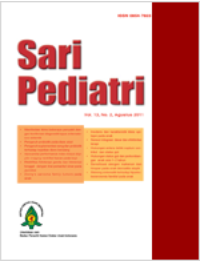Hubungan Berat Lahir dengan Skor Gangguan Pemusatan Perhatian/Hiperaktivitas pada Anak yang Memiliki Riwayat Berat Badan Lahir Rendah Kecil Masa Kehamilan
Sari
Latar belakang. Berat badan lahir rendah kecil masa kehamilan (BBLR KMK) masih merupakan penyebab utama masalah kesehatan pada anak, termasuk gangguan pemusatan perhatian/hiperaktivitas (GPPH). Hubungan yang konsisten antara BBLR KMK dan GPPH hingga kini masih diperdebatkan. Penanganan GPPH sedini mungkin dapat memperbaiki prognosis GPPH sehingga alat diagnosis yang baik menjadi penting. Abbreviated Conners Rating Scale (ACRS) merupakan alat yang mudah dan sudah divalidasi dalam mendeteksi GPPH.
Tujuan. Untuk melihat hubungan BBLR KMK dengan GPPH pada anak usia 5-8 tahun dengan menggunakan ACRS.
Metode. Desain penelitian adalah penelitian observasional dengan pendekatan potong lintang pada periode 1 November 2016 sampai 31 Januari 2017. Subyek penelitian adalah anak usia 5-8 tahun yang lahir di RSUP Prof Dr. R.D Kandou, Manado, dengan riwayat BBLR KMK. Besar subyek penelitian minimal 38 anak (α=0,05%, p=0,8). Variabel bebas adalah berat lahir dan variabel tergantung adalah skor ACRS. Analisis statistik menggunakan uji Pearson dan regresi linear. Statisik bermakna bila p <0,05.
Hasil. Pada penelitian ini didapatkan 40 anak yang memenuhi kriteria inklusi, 16 perempuan, dan 24 laki-laki. Rerata umur subyek penelitian adalah 6,8 tahun dan rerata berat lahir 2055 gram. Skor ACRS yang didapatkan antara 3-14 dengan rerata 8,4. Analisis bivariat didapatkan hubungan negatif sangat kuat dan sangat bermakna antara berat lahir dan skor GPPH (r=0,883 dan p<0,0001), dengan uji regresi linear didapatkan persamaan y=24,493 - 0,008x.
Kesimpulan. Semakin rendah berat lahir anak dengan riwayat BBLR KMK maka semakin tinggi kemungkinan terjadinya gangguan pemusatan perhatian dan hiperaktivitas (GPPH). Skor ACRS dapat digunakan sebagai skrining awal GPPH pada anak pra sekolah (5-8 tahun).
Kata Kunci
Teks Lengkap:
PDFReferensi
Gomela TL, Cunningham DM, Eyal FG, Tuttle DJ. Neonatology, management, procedures, on-call problems, diseases, and drugs. Edisi ke-7. New York: Mc Graw Hill education; 2013: h.29-42.
Bhutta AT, Cleves MA, Casey PH, Cradock MM, Anand KJS. Cognitive and behavioral outcomes of school-aged children who were born preterm, A meta-analysis. JAMA 2002; 288:728-37.
Mick E, Biederman J, Prince J, Fischer MJ, Faraone SV. Impact of low birth weight on attention-deficit hyperactivity disorder. J Dev Behav Pediatr 2002;23:16-22.
Cormier E. Attention deficit hyperactivity disorder. A review and update. J Pediatr Nurs 2008 23:345-57.
Lahey B, Pelham W, Atkins A, Loney J, Lee S. Instability of the DSM-IV Subtypes of ADHD from preschool through Elementary School. Arch Gen Psychiatry 2005;62:896-902.
Baihaqi MIF, Sugiarmin M. Memahami dan membantu anak ADHD. Bandung: Refika Aditama; 2006.
Golmirzaei J, Namazi S, Amiri S, Zare S, Rastikerdar N, Hesam A, dkk . Evaluation of attention-deficit hyperactivity disorder risk factors. Int JPediatr 2013;23:1-6.
Kim HW. Cho SC, Kim BN, Shin MS, Kim Y. Perinatal and familial risk factors are associated with full syndrome and subthreshold attention-deficit hyperactivity disorder in a Korean community sample. Psychiatry Investigation 2009;6:278-85.
Cantwell DP. Attention deficit disorder: a rewiew of the past 10 years. J Am AcadChild Adolesc Psychiatry 1996;35:978-87.
Wolraich ML. Attention-deficit/hiperactivity disorder: can it be recognized and treated in children younger than 5 years? Infant and young children 2006;19:86-93.
Ojeda NB, Grigore D, Alexandra BT. Intrauterine Growth Restriction: fetal programming of hypertension and kidney disease. Advanc in Chronic Kidney Dis 2008;15:101-6.
Gilberto B. The conners abbreviated teacher rating scale: development on Norms in Brazil. J Abnorm Child Psycol1987;15:511-8.
Petterson E, Sjolander A, Almqvist C, Anckarsater H, D’Onofrio BM, Lichtensen P, dkk. Birth weight as an independent predictor of ADHD symptoms: a within-twin pair analysis. J Child Psychol Psychiatry 2015;56:453-9.
Hack M, Taylor HG, Schulchter M, Andreias L, Drotar D, Klein N. Behavioral oucomes of extremely low birth weight children at age 8 years. J Dev Behav Paediatr 2009;30:122-30.
Botting N, Powls A, Cooke RWI, Maslow N. Attention deficit hyperactivity disorder and other psychiatric outcomes in very low birthweight children at 12 years. J Child Psychol Psychiatry 1997;38:931-41.
Sasaluxnanon C, Kaewpornsawan. Risk factor of birth weight below 2,500 grams and attention deficit hyperactivity disorder in Thai Children. J Med Assoc Thai 2005;88:1514-18.
Indredavik MS, Vik T, Evensen KA, Skranes J, Taraldsen G, Brubakk AM. Perinatal risk and psychiatric outcomes in adolescent born preterm with very low birth weight or term small for gestational age. J Dev Behav Paediatr 2009;31:286-94.
Ahmed M, Verma S, Kumar A, Siddiqui M. Enviromental exposure to lead and its correlation with biochemical indices in children. Sci Total Environ 2009; 346: 48-55.
Lahat A, van Lieshout RJ, Saigal S, Boyle MH, Schmidt L. ADHD among young adults born et extremely low birth weight: the role of fluid intelligence in childhood. Frontier in Psycology 2014;5:1-7.
Menkes JH. Toxic and nutrional disorders. Dalam: Lippincott Wiliams and Wilkins; 2000.h.743-8
Galera C, Cote SM, Bouvard MP, Pingault JB, Melchior M, Michel G, dkk. Early risk factors for hyperactivity-impulsivity and inattention trajectories from age 17 months to 8 years. Arch Gen Psychiatrty 2011;68:1267-75
Obel C. Linnet KM, Hendriksen TB. Smoking during pregnancy and hyperactivity-inattention in the offspringcomparing results from three Nordic cohorts. Int J Epidemiol 2009;38:698-705.
Langley K, Holmas P, Van M, Thapar A. Effects of low birthweight, maternal smoking in pregnancy and sosial class on the phenotypic manifestation of attention deficit hyperactivity disorder and associated antisosial behavior: Investigation in a clinical sample. BMC Pshyciatry 2007;27:26-34.
Schachar RJ, Park LS, Dennis M. Mental Health Implications of Traumatic Brain Injury (TBI) in Children and Youth. J Can Acad Adolesc Psychiatry 2015;24;2:100-108.
DOI: http://dx.doi.org/10.14238/sp21.3.2019.170-6
Refbacks
- Saat ini tidak ada refbacks.
##submission.copyrightStatement##
##submission.license.cc.by-nc-sa4.footer##
Email: editorial [at] saripediatri.org


Sari Pediatri diterbitkan oleh Badan Penerbit Ikatan Dokter Anak Indonesia
Ciptaan disebarluaskan di bawah Lisensi Creative Commons Atribusi-NonKomersial-BerbagiSerupa 4.0 Internasional.




